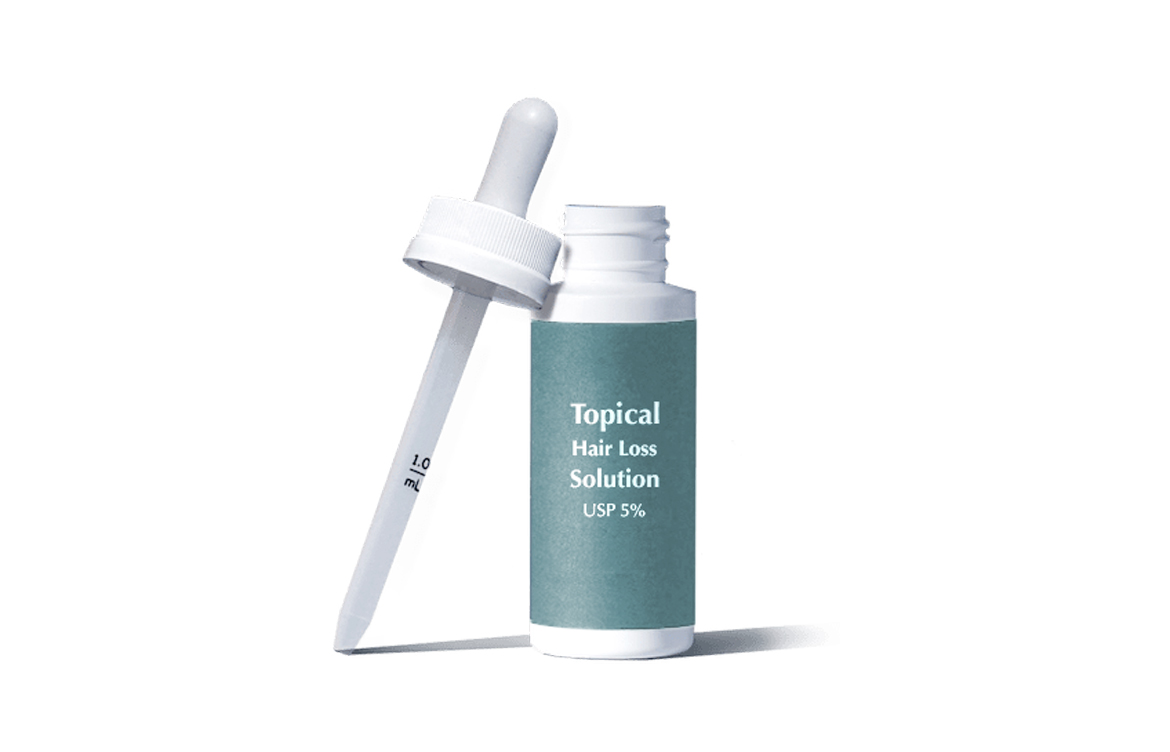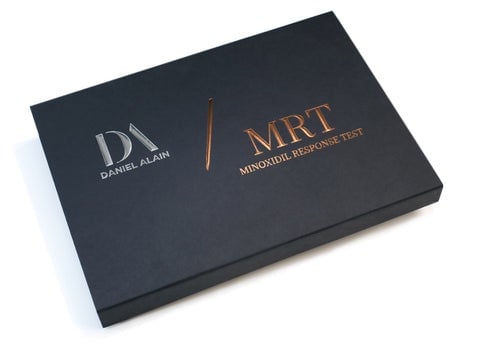Hair Shedding | Hair Loss Testing | Hair Loss | Men's Minoxidil | Women's Minoxidil
Will Rogaine® Work For Me? Can It Actually Stop Thinning Hair?

Will Rogaine® Work For Me ?
For years, this question has been virtually unanswerable thanks to stagnant research and marketing tactics boasting it as a cure-all for hair loss. What have we learned about “cure-alls?” If they sound too good to be true, they likely are.
If you’re dealing with hair loss, the last thing you want to do is demystify the smoke and mirrors of the hair-growth product market. Not to worry, because we’re doing it for you. We know how overwhelming it can be to find effective solutions. That’s why we took action and funneled our efforts into intensive research and development.
Here, we’re finally putting an end to the mystery of Rogaine®’s potency so that you’ll know if you’ve got the biological framework for Rogaine® to work.
Because, as we’re about to share, our research led to a breakthrough, and we now know exactly what you need to see results from Rogaine®.
Background
Rogaine® is the popular brand name for Minoxidil, the most commonly-used FDA-approved topical hair loss treatment for men and women. Since its development in the 1980s, Rogaine® has been a leading brand offering a hair growth treatment to men and women with hereditary hair loss. That said, it doesn’t work for everyone.
Manufacturers claim that with regular topical application, Rogaine® (Minoxidil) may increase hair density and stimulate regrowth in balding or thinning areas.
But does this topical Minoxidil treatment really work? Brands like Rogaine®, Hims, and Hers claim that statistically, the treatment reduces hair loss. However, the evidence is more than blurry, considering that the product’s potency proved to only provide “minimal” to “moderate” regrowth in early clinical trials. Moreover, results take 6-9 months, resulting in a painstaking waiting game.
We’re all for minimalism and moderation, but not here.
Are you willing to invest in treatment before knowing its efficacy? For decades, this has been the predicament of millions of people battling hair loss.
We’re leveling the playing field by providing a patented, proven way to know if Rogaine® will work for you.
Introducing the Minoxidil Response Test from Daniel Alain
Until now, there hasn’t been a way to test if Minoxidil will work for you. Our breakthrough, the Minoxidil Response Test (MRT), is the first and only clinically proven and doctor-developed test designed to analyze hair samples in a lab.
This process enables us to evaluate your scalp’s environment to determine whether you have the necessary enzymes present in your hair follicles to react positively to Rogaine® (Minoxidil) application.
The results, validated with 95.9% accuracy, will give you confidence whether or not you should proceed with Rogaine® treatments. Considering Rogaine® can take up to 6-9 months, the MRT test leads you straight to answers, saving you valuable time and money.
Less mystery, more transparency.
Does Rogaine® really work, and if so, how does it work? Before we dive into how our Minoxidil response test works, let’s talk more about the industry narrative surrounding Minoxidil products.
HOW DOES ROGAINE® WORK?
While researchers first developed the drug for men with Male Pattern Baldness, the FDA later approved it as a topical treatment for women with genetic hair loss.
Rogaine® is a vasodilator, meaning it enlarges the hair follicles to receive more nutrients and, in turn, prolongs the growth period of the Hair Growth Cycle.
The general understanding for decades was that Rogaine® sends more follicles into the growth (anagen) phase, enabling the scalp to produce more hairs in thinning or balding areas.
Our recent discovery unlocks a critical piece of the puzzle that had been missing: the role of a necessary enzyme to convert and activate Minoxidil. We now know precisely why Rogaine® doesn’t work for everyone: because not everyone has that enzyme.
We’ve uncovered this missing link from ten years of extensive research. Before we expand on this, let’s look into the product itself.
WHAT IS ROGAINE®?
Rogaine® is a topical drug applied once or twice daily to the scalp, depending on the solution volume. The primary ingredient in Rogaine® is Minoxidil, which was first designed to treat patients with high blood pressure.
During early trials for hypertension patients, researchers noticed it helped stimulate hair regrowth in some balding men. They hypothesized that Minoxidil might work as a hair growth treatment.
Over the years since its inception, scientists have worked to make Rogaine® accessible to men and women — but that doesn’t mean it works for everyone. Specifically, Rogaine® is most helpful in stimulating hair regrowth in patients with Androgenetic Alopecia.
Rogaine for Men vs. Rogaine for Women
The main difference between using Rogaine® for men and women is the solution volume. Men’s Rogaine® is administered in 5% solution, whereas women use 2%. However, Rogaine® rolled out a 5% foam formula for women in 2014.
Despite clinical studies boasting the solution’s effectiveness, one factor seems buried under zippy numbers and slogans: who Rogaine® helps.
Rogaine® only has the potential to help men and women with genetic hair loss. While genetic hair loss is prevalent, it isn’t exclusive. So people with other hair loss conditions might invest false hope into a product unintended to treat their hair loss cause.
This distinction is crucial, especially in light of our emerging research.
And for 2% minoxidil treatment in women with female genetic hair loss? Only 13-20% of them experienced moderate hair regrowth. And again, this regrowth didn’t occur until about eight months.
I don’t know about you, but the term moderate leaves something to be desired.
With the 5% solution, only about 40% of patients may respond to Minoxidil.
There’s long been a missing link between application and results. Our Minoxidil Response Test will close the gap by providing the first-ever diagnostic test designed to save non-responders (patients with Androgenetic alopecia lacking the SULT1A1 enzyme) time and money.
Not to mention the emotional rollercoaster of investing in a product, waiting 6-9 months to see if it works, and ultimately, dealing with the onslaught of emotions when results don’t come.
The fact is that Rogaine®’s results are a gamble. Why invest 6-9 months only to find out the product doesn’t work for you? Instead, order our Minoxidil Response Test for results you can count on.
HOW DOES ROGAINE® WORK TO REGROW HAIR?
Until now, the consensus has been that topical Rogaine® works by opening the scalp’s blood vessels to receive more nutrients and oxygen. In turn, follicles enter the growth phase and stimulate new hairs to grow.
However, our meticulous research has unlocked critical evidence on exactly how the active ingredient, Minoxidil, in Rogaine® works.
Minoxidil converts in the scalp into an active form called minoxidil sulfate. And what aids that conversion?
For the active ingredient Minoxidil to be effective in Rogaine®, you need to have an enzyme called sulfotransferase (SULT1A1) present in your hair follicles. SULT1A1 is necessary to convert and activate Minoxidil. Without this enzyme, Rogaine® will not work on your scalp.
So, why isn’t Rogaine® prescribed for everyone suffering from hair loss? Because not every hair loss patient is experiencing genetic hair loss. While genetics cause 80% of male hair loss, and 50% of women’s hair loss, there are many other causes of hair loss outside of the lines of genetics, including:
- Medications
- Medical Illness
- Alopecia
- Chemotherapy
- Stress
- Extreme Dieting
- Environmental Influences and Pollutants
- Postpartum Hair Loss
- Menopause
- Thin Hair
- Seasonal Hair Shedding
- Traction and Pulling
CAN ROGAINE® WORK FOR ME?
To reiterate: Rogaine® is ONLY a hair loss treatment option for people with genetic hair loss. So we need to reframe the question from “will Rogaine® work for me?” to “Am I experiencing genetic hair loss?”
For decades, people had to play the guessing game of trial and error, spending hard-earned money and taxing their emotional wellbeing only to be disappointed with a lack of results.
How can you find out if you have the SULT1A1 enzyme necessary for Rogaine®’s efficacy?
Our research led us to the startling realization that the hair-growth industry is riddled with misinformation. And that’s what led us to the patented development of Rogaine® Minoxidil testing with the Minoxidil Response Test.
Does Rogaine® Work For Thinning Hair?
If your hair is thinning from genetic hair loss and you discover that your scalp contains the SULT1A1 enzyme, Rogaine® can help. However, hair thinning is progressive, and treatment should begin while you still have hair follicles to stimulate. Unfortunately, once the scalp is bald, there is no real chance for regrowth — even if you have the enzyme.
Women and men experiencing thinning at the crown of the scalp are optimal candidates for Rogaine® topical application if it is determined their hair loss is genetic.
HOW LONG DOES IT TAKE FOR ROGAINE® TO WORK?
Seeing results from Rogaine® is a different experience for everyone and depends on the stage of hair loss you’re experiencing. The general perception is that Rogaine® takes only a few months to take effect, but the evidence in clinical studies says otherwise.
In the original FDA study, it took 6-9 months to see results. Why invest 6-9 grueling months of waiting on the chance that the product might work?
Gender also influences results, as it can take longer for women to see regrowth than men.
What does the latest science show?
Our clinical research shows that androgenetic alopecia (genetic hair loss) patients respond to 5% topical minoxidil after about 3-6 months of daily application. Again, you have to know that you have genetic hair loss and the enzyme to see results.
Why gamble? You can know for sure if Rogaine® will work for you by taking our quick and effective Minoxidil Response Test.
HOW DO I KNOW IF ROGAINE® IS WORKING?
Rogaine® begins working immediately after scalp application. However, this is contingent on you being a respondent with the SULT1A1 enzyme.
The first sign that Rogaine® is working might alarm you: you may begin to see an increase in hair fall and shedding, resulting from the new hairs pushing out the old strands. If your scalp has the right environment to be a responder (the SULT1A1 enzyme), shedding is a sign that Rogaine® is working.
At this point, you must continue with daily application to produce optimal results. Other symptoms that indicate effectiveness are increased hair length and strand density. Meaning your hair may start to feel longer and thicker.
The waiting game can be daunting. That’s why we want to help you ditch the guessing game with our Minoxidil Response Test. The test will tell you if your hair follicles are equipped with the essential enzyme present to activate Minoxidil for hair regrowth.
Daniel Alain is the only company in the world that can offer you this peace of mind. Our mission is to provide a new standard for hair loss solutions and treatment. We’ve invested ten years and 10 million into our research and development.
SHOULD I USE ROGAINE®?
There's a lot to consider before trying Rogaine®, most notably:
- Do you have genetic hair loss?
- If so, do you have the essential enzyme to activate Minoxidil, the essential ingredient in Rogaine® for hair regrowth?
You’ll know for sure if the answers are yes by taking our Minoxidil Response Test, which has a 95.9% success rate. Even if you’re a responder, you should avoid Rogaine® if:
- You're pregnant or plan to become pregnant.
- You don't have a genetic predisposition to hair loss.
- You're under 18 years old.
- Your hair loss is falling out in sudden clumps or patches.
With our discovery of the role the SULT1A1 enzyme plays in Rogaine®’s potency, you can know with utmost confidence that the enzyme means Rogaine® will work for you. What if you don’t have the enzyme?
While the initial result may be disappointing, you’ll save yourself frustration, time, and money in the long run. Plus, you’ll set yourself on a faster course to better options for you right now.
FREQUENTLY ASKED QUESTIONS ABOUT ROGAINE®
Do you still have questions about Rogaine®? We’ve got you covered! Read these FAQs for answers.
Does Rogaine® actually work?
Yes, Rogaine® (also known as Minoxidil) works but has a relatively low response rate. 30-40% of people with androgenetic alopecia respond to Rogaine®, and patients must have the essential enzyme SULT1A1. Consistent topical application will yield the most significant results. However, not everyone has the optimal scalp environment to react positively to Rogaine®, which is why we encourage you to take our Minoxidil Response Test first.
What are the side effect of using Rogaine®?
Common side effects of Rogaine® include dry scalp, irritation on the scalp, sunlight sensitivity, scalp burning, itching, scaling, and flaking. 5% Rogaine® solutions may cause hair growth in non-targeted areas like the cheeks or chin. Women with color-treated hair may experience more intense side effects, including lightheadedness and scalp irritation. If you experience extreme symptoms like nausea, weight gain, facial swelling, dizziness, chest pain, or heart palpitations, immediately stop using Rogaine® and see your doctor.
Is Rogaine® a drug?
Yes, Rogaine® is a brand-name topical solution containing the active ingredient, Minoxidil, which belongs to a group of drugs called vasodilators. Initially, Rogaine®’s active ingredient, Minoxidil, was an antihypertensive drug used to treat hypertension patients. Today, Rogaine® is a topical drug for genetic hair loss in men and women.
Are Minoxidil & Rogaine® the same?
Minoxidil is a generic drug and the active ingredient in the brand name Rogaine®, a topical hair loss treatment. Rogaine® and Minoxidil have different names and may have other inactive ingredients, but the active ingredient is the same in each drug. While consistency may vary in the product’s texture (due to varying inactive ingredients), the active ingredient’s potency (Minoxidil) is the same.
Does Rogaine® stop hair loss?
Rogaine® is statistically proven to be moderately effective as a hair loss treatment in clinical studies and trials. The results are moderate because participants in trials may be experiencing different types of hair loss. Rogaine® is most effective at treating men and women with Androgenetic Alopecia, a genetic hair loss issue, who have the essential SULT1A1 enzyme to respond to Minoxidil.
Can Rogaine® regrow lost hair?
Not if the hair loss is permanent. However, if your hair is thinning and shedding in excess due to genetic hair loss, Rogaine® can stimulate regrowth if your follicles have the SULT1A1 enzyme. However, if the hair follicles have completely miniaturized, the chance of regrowth is slim. Additionally, Rogaine® cannot revive a receding hairline or regrow hair on a bald scalp.
Do you have to use Rogaine® forever?
Yes. If you’re having success using Rogaine® treatments for hair loss, you’ll need to continue with topical application indefinitely. Otherwise, ceasing treatment will send your hair back to the original condition it was in when you began treatments. Without Rogaine®, the scalp remains untreated, and the progression of hair loss will resume.
Does Rogaine® work for everyone?
No. Rogaine® only works for people who have androgenetic alopecia AND the essential SULT1A1 enzyme. Certain groups of individuals are not qualified to use Rogaine® safely. Pregnant women, women trying to conceive, children under 18, and some elderly individuals should avoid treatment.
Does Rogaine® work for beards?
The research on beard growth effectiveness is budding. In a controlled study in Thailand, researchers evaluated the safety and success rate of applying 3% minoxidil to people struggling to grow a beard. Of 46 participants applying minoxidil lotion twice daily, results showed moderate increases in hair diameter and hair count in the 3% Minoxidil group.
The study deemed Rogaine® safe, but effectiveness is still in question.
Why isn't Rogaine® working for me?
There are several reasons. One is that your follicles do not contain the necessary SULT1A1 enzyme to convert and activate Rogaine®’s active ingredient, Minoxidil. If you are a responder and have genetic hair loss, it may not show results until 3-6 months after daily application. If you’ve just started applying the solution and your hair is shedding excessively, that’s a sign that Rogaine® is working because new hair is pushing out old hair on your scalp.
How do I know if Rogaine® will work for me?
If your hair loss is along the hairline or at the front of your scalp, then Rogaine® might not be an effective hair fall treatment for you. We suggest that you consult with your dermatologist and discuss your symptoms and medical history. The most direct way to determine if the treatment will work for you is to take a Minoxidil Response Test. The test is patented and lab-based with 95.9% accuracy.
Can I be tested to see if Rogaine® would work for me?
Yes, and we encourage you to do so! The Daniel Alain Minoxidil Response Test analyzes your hair samples to assess the condition of your scalp. The test is non-invasive and evaluates whether your scalp has the enzymes to respond to the active ingredient Minoxidil found in Rogaine® treatments.
How does Rogaine® (Minoxidil) testing work?
Rogaine® testing uses hair samples from your scalp to evaluate the condition of the follicles, enzymes, and scalp environment. With this information, we can determine whether or not your scalp will positively respond to Rogaine®. All you have to do is send in six hair samples from your scalp, and you’ll receive results within a week. Because the test is 95.9% accurate, you can trust that the results will give you the most precise analysis.
How much does Rogaine® (Minoxidil) testing cost?
The Minoxidil Response Test is $139, or you can make four interest-free payments of $35. Taking the test will save you money long-term because you won't waste money on treatment if you’re not a candidate. If you discover that your scalp is optimal for regrowth treatment, it’s money well spent toward your treatment plan — and you won’t have to guess along the way if it’s working.
Where can I get a Minoxidil Response Test?
You can buy a Minoxidil Response Test from Daniel Alain, the industry expert on hair loss science, research, and solutions. Our Minoxidil test is CLIA-certified, lab-based, patented, and clinically proven to be 95.9% accurate.

BUY MINOXIDIL RESPONSE TEST NOW
All product and company names are trademarks ™ or registered marks ® of their respective holders. Use of them does not imply any affiliation with or endorsement by them.

